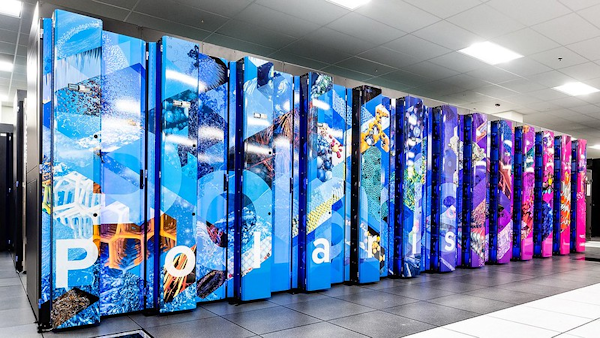SEJournal Online is the digital news magazine of the Society of Environmental Journalists. Learn more about SEJournal Online, including submission, subscription and advertising information.
 |
 |
| Among the ways AI may affect environmental journalism is its use to analyze large datasets, including around climate change. Above, a supercomputer at Argonne National Laboratory in Illinois, used for simulation, data analysis and AI tasks. Photo: U.S. Department of Energy (United States government work). |
EJ Academy: AI’s Importance in Journalism and Teaching — Part 2
By Emilia Askari
In Part 1 of this two-part EJ Academy column, the author examined practical insights into the smart use of AI for teaching young reporters. Part 2, below, examines how AI tools are changing the context of journalism and emerging ways to use AI more effectively.
Perhaps the most obvious way that artificial intelligence is challenging journalists and journalism educators is by changing how we perceive cheating in every written context — class assignments, bylined stories and other forms of writing. How do we even define plagiarism in the age of AI?
Last year, while teaching my environmental journalism classes at the University of Michigan, I showed a short, scary video describing tools that one could use to attempt to screen for AI-generated text. Later, several students turned in final versions of their news stories that were markedly different from their first drafts. I suspect that the first drafts might have been written by AI — though the students initially had failed to acknowledge that assist.
The wide access to generative AI
is propelling so much change that
it is pointless to keep teaching without it.
Like many others, I find that AI has forced me to take extra time in editing. Despite this, I feel that the wide access to generative AI is propelling so much change that it is pointless to keep teaching without AI, as we did just a couple of years ago.
Here are some ideas on how to elevate discussions about AI’s impact on journalism, starting with nine ways that AI currently is changing the context of journalism and then looking on the horizon to consider four more ways to use AI more effectively.
- Use AI as a writing tool: I encourage students to do their own writing by telling them they are better than a tone-deaf program that turns out homogenized, stilted writing. But I do not ignore the presence of AI. I ask my students to highlight any parts of their stories that were suggested by AI. I tell them that the portions suggested by AI should be short, certainly less than a quarter of their overall draft. I remind them that I have confidence in their writing ability, and I am here to make their writing better.
- Use AI to demonstrate the importance of fact-checking: AI does “hallucinate” and make up things that sound plausible. This creates great opportunities to demonstrate the importance of fact-checking, and emphasize that students — and professional journalists — are 100% responsible for the accuracy of every word, sound or image in their news stories.
- Use AI to demonstrate the stereotypes embedded in digital spaces: This Washington Post article demonstrates one approach to doing this. Here’s another example, from the British outlet, Rest of World. I’m very interested in how this problem might be addressed by a new AI tool, trained on diverse perspectives, called Latimer.ai. The founders are working with several historically Black colleges and universities, and I suggest you consider collaborating with Latimer as well.
- Talk about how AI can be used to manipulate perceptions: This is especially an issue with images and video. But audio fakes also are a problem that may not be getting enough attention, according to some experts. Misinformation in digital spaces is a vast and deeply troubling topic, made worse by AI — that possibly also can be addressed with help from AI, at least in part.
- Talk about how AI is changing and extending analysis of all data: That includes environmental data. On the plus side, many scientists —– actually academics across every discipline — are excited about the possibilities that generative AI brings to analysis of all kinds of large datasets. For example, AI might quickly recognize patterns in satellite image data and draw conclusions about climate change that would take much longer to notice by other means.
- Explore the connections between AI and creativity: The opportunities to use AI to help solve problems go beyond analysis and are even moving into the realm of creativity. Experts suggest that AI can sometimes help people think more creatively, and also that AI can outscore most humans on tests of creativity or the ability to offer fresh ideas. I have been in a conference room with many distinguished math professors talking in ecstatic terms about generative AI’s ability to creatively solve a long-standing math problem.
- Talk about how news organizations are responding to and using AI: It seems like every week brings new stories on this topic. Some of the journalism leaders who are leading these conversations are The Associated Press’ Aimee Rinehart, Hacks/Hackers’ Paul Cheung and the Local Media Association’s Frank Mungeam. In addition, Reuters Institute for the Study of Journalism is doing some smart research and analysis on AI and journalism. So is the Tow Center for Digital Journalism at Columbia University.
- Acknowledge the tremendous energy needs created by generative AI: That’s a contributor to climate change, reason enough to encourage students to use AI cautiously. One criticism of AI is that it requires much more energy than other uses of information technology. Harvard Business Review offers some ideas about reducing the carbon load of AI, by using it only when it significantly improves outcomes. Experts at Columbia University's Climate School estimated in June 2023 that the data center behind AI contributed 2.5-3.7% of global carbon emissions — exceeding the carbon emissions of the airline industry.
- Beware of AI-powered transcription services: Tools such as Otter.ai take ownership of the interviews you upload. Politico did an interesting piece on this in 2022. If your students have access to premium accounts on Zoom, consider having students run their interview recordings through Zoom to create rough transcripts.
- Consider using AI to build tutoring tools into your course website: This is one use of AI that might reduce the amount of time teachers spend on simple questions from students, so we can focus more of our attention on more complex conversations with students. An example of an AI tutor tool that’s accessible for anyone to try is Khan Academy’s Khanmigo. The University of Michigan has developed its own AI tutor tool, Maizey (here’s a short video about it). And I’m guessing similar tools are being developed at other universities.
- Keep an eye on emerging AI tools beyond text generation that may make your life easier: For example, I’m seeing other people speak highly about other professional uses of AI — as a kind of career coach. I’m also seeing that some professors have had success using AI to grade tests with clear right or wrong answers. Tools exist that purport to use AI to help with grading essays. In the basic environmental journalism course I co-teach with Julie Halpert, we do have students participate in a course blog and a course X account — though we plan to move away from X and introduce a new course account on a different social media platform in early 2025.
- Follow efforts to regulate AI: Think about how journalists might not just cover but also perhaps contribute to those conversations. Environmental journalists should not be surprised by the fact that regulation of AI is stricter in Europe than it is so far in the U.S. — paralleling stricter European regulation in other areas, from pesticides to digital privacy. But more legislation and regulation addressing AI is widely anticipated, in the U.S. and around the world.
- Be (somewhat) aware of new AI tools or features developed by tech companies: I personally give this kind of update lower attention than many others. The pace of new developments related to AI is daunting, and I don’t prioritize being the first to know about all the latest wrinkles — but here’s one way to keep up if you feel differently.
It is hard to process every opportunity and challenge created by AI and decide how to use it responsibly. I try to manage the “gushing hose” of information and analysis related to AI by scheduling a chunk of time every other week to get a bit acquainted with one new thing related to AI.
When I talk with my students about AI, I frequently acknowledge that we’re all learning together, and none of us have all the answers. I also tell my students, and I truly believe, that I feel so lucky to be an environmental journalist at this time of great innovation, both in journalism and in response to climate change. I’m counting on environmental journalists and others to help as we all develop our understanding of AI and how to use it in the smartest ways, to advance our field.
[Editor’s Note: For additional perspectives on AI and journalism, check out two WatchDog Opinion columns on whether AI will make it easier to limit press freedom and a look at how wildfire disinformation, aided by AI, became a state weapon. Plus, mark your calendars for May 3, World Press Freedom Day, which as its theme this year is exploring the impact of artificial intelligence on press freedom and the media.]
Emilia Askari, who has a PhD in educational technology, teaches environmental journalism at the University of Michigan. She also advises a news nonprofit, Planet Detroit; judges the Oakes Award for Environmental Journalism; and serves on numerous Society of Environmental Journalists committees. She is co-editor of EJ Academy.
* From the weekly news magazine SEJournal Online, Vol. 10, No. 6. Content from each new issue of SEJournal Online is available to the public via the SEJournal Online main page. Subscribe to the e-newsletter here. And see past issues of the SEJournal archived here.













 Advertisement
Advertisement 



